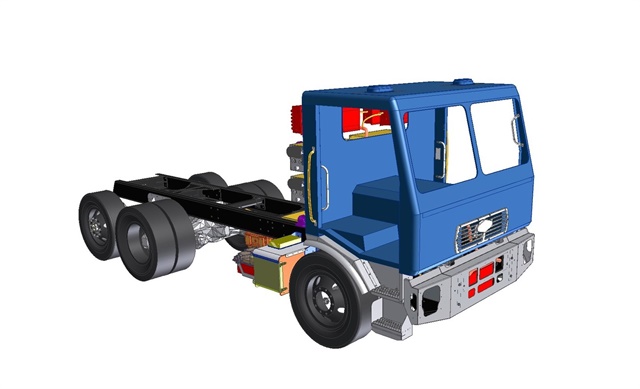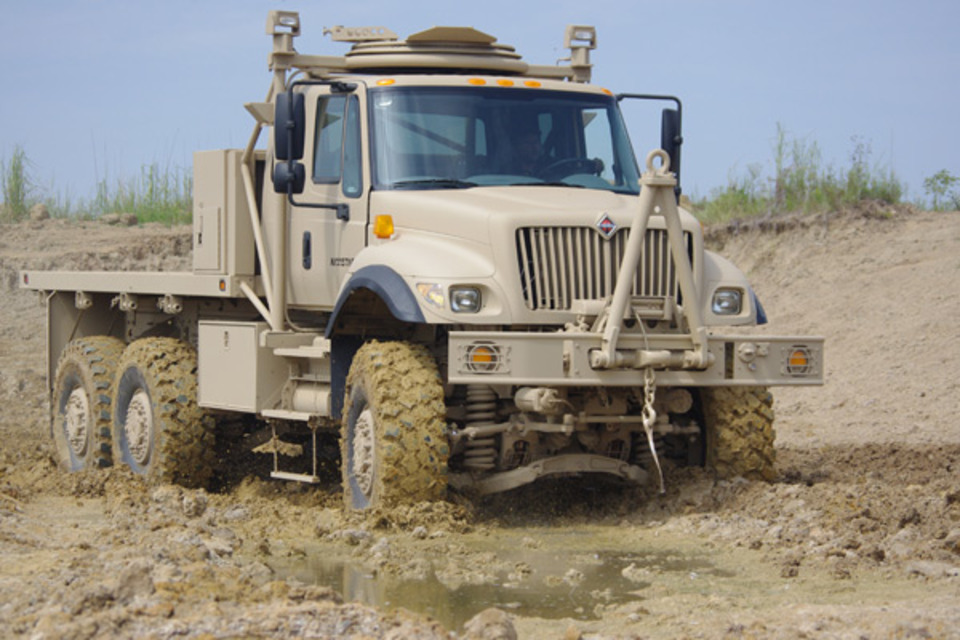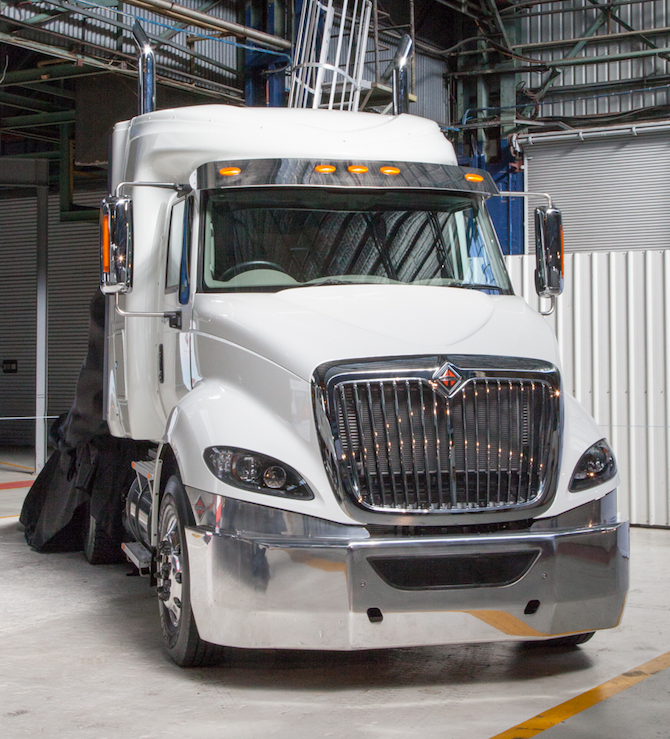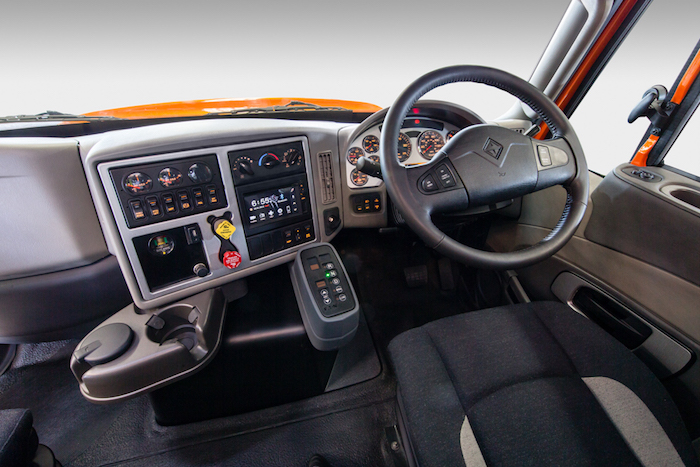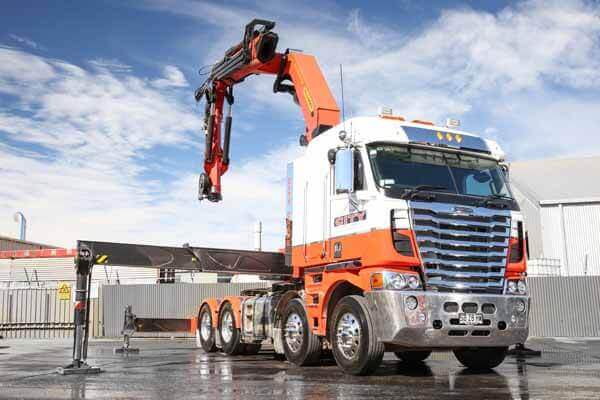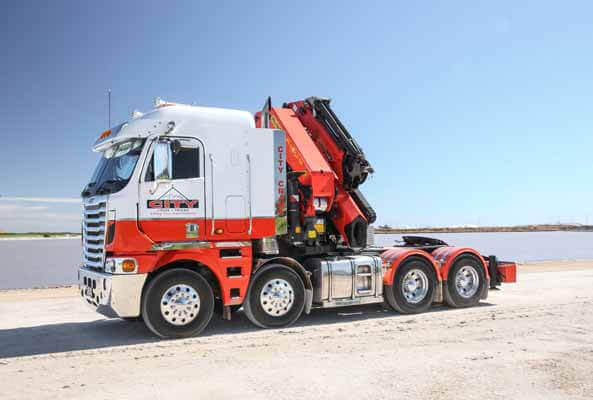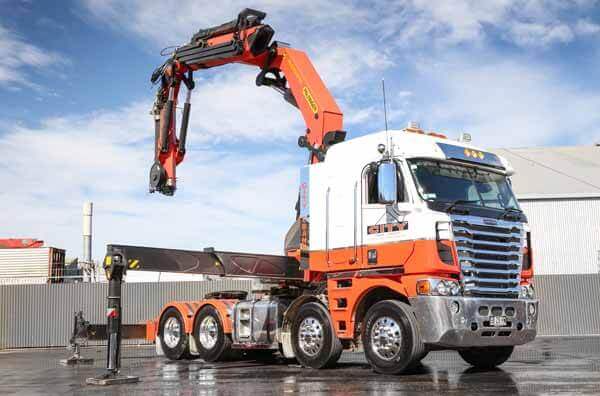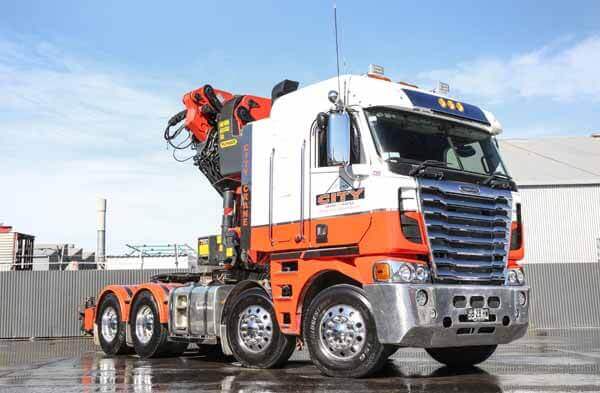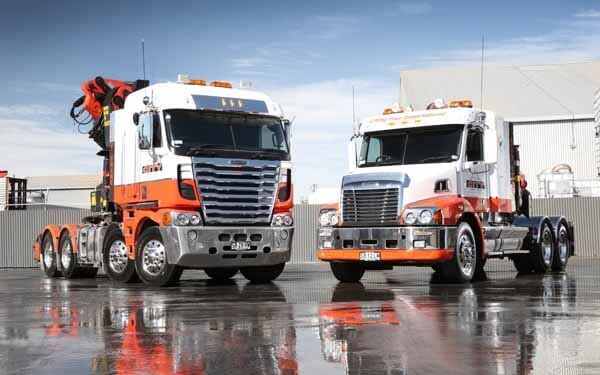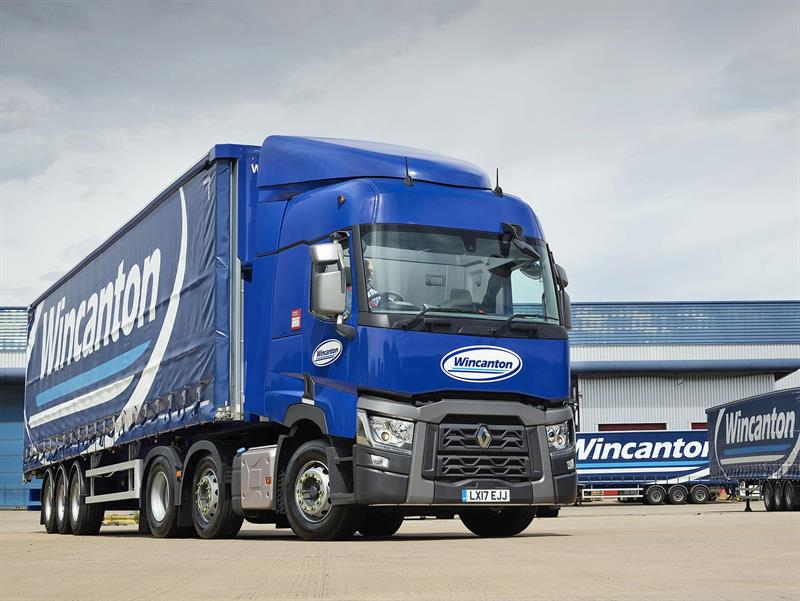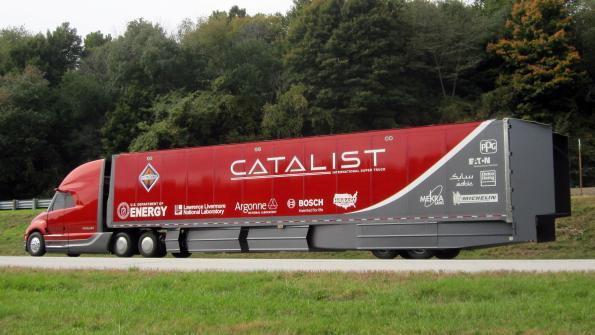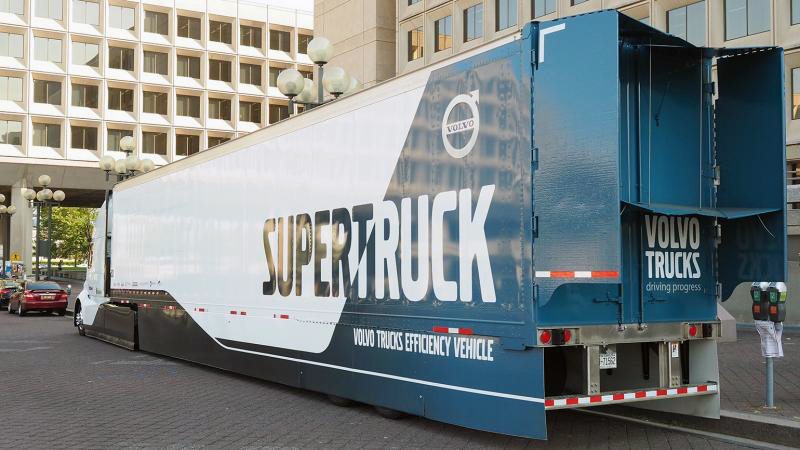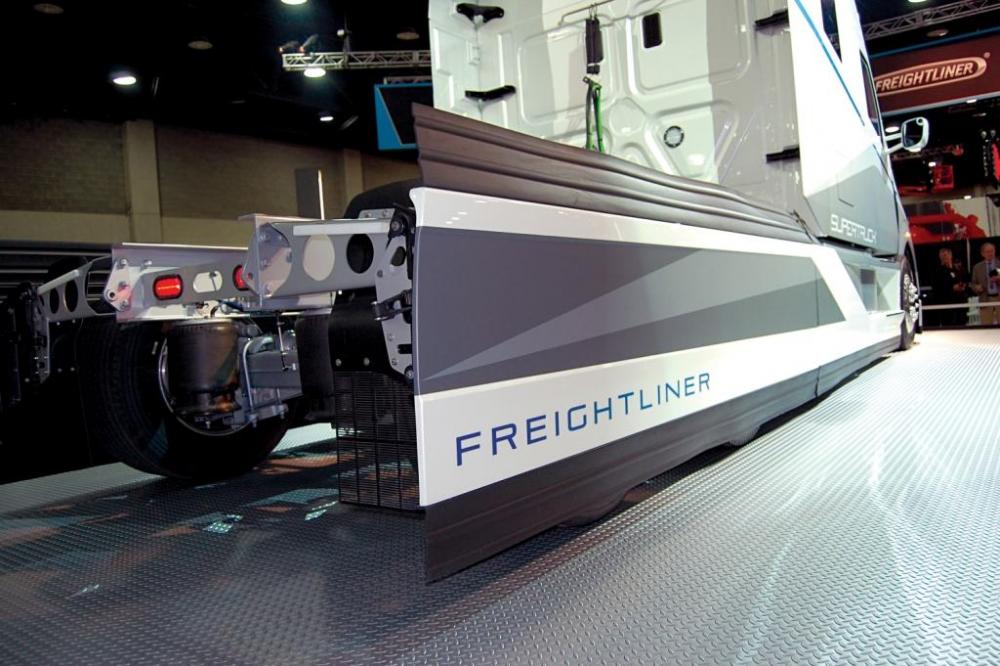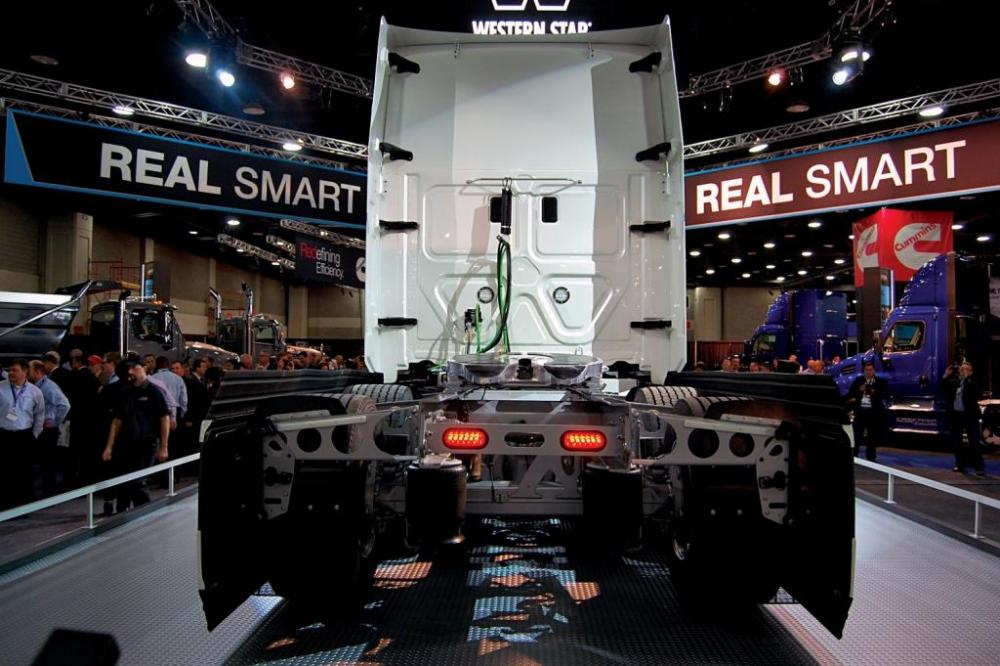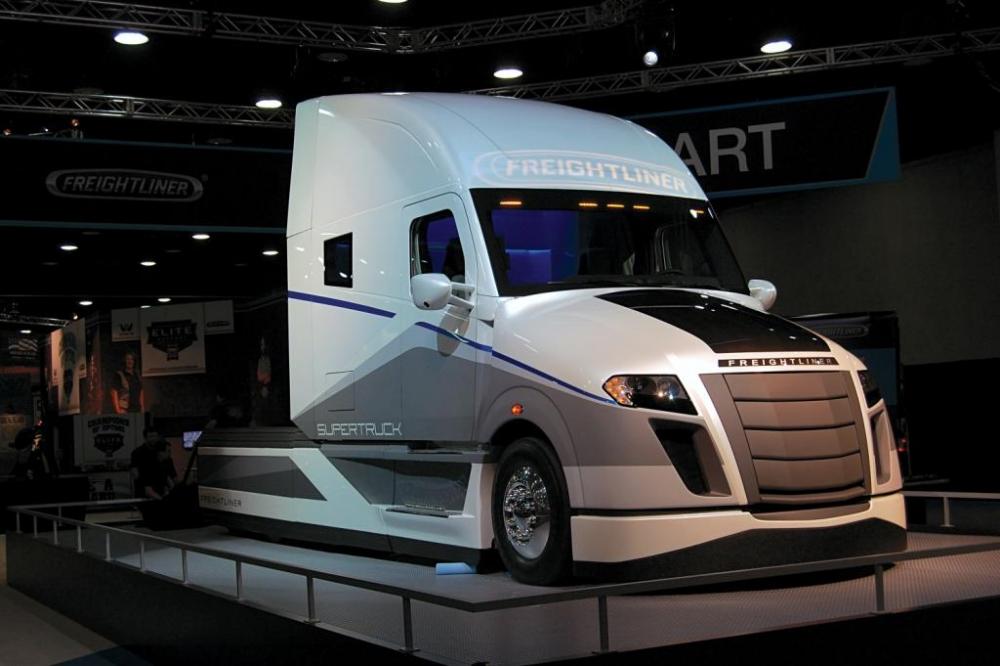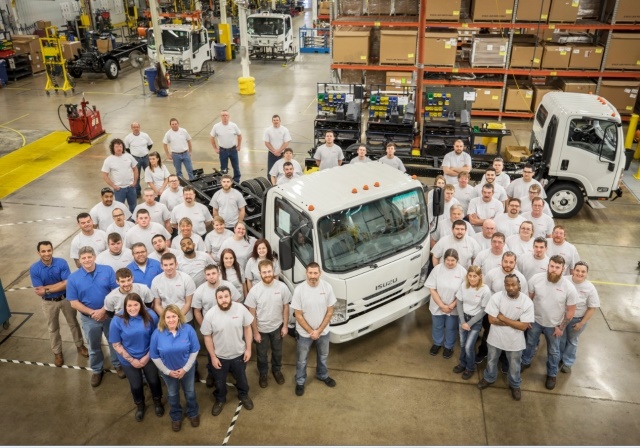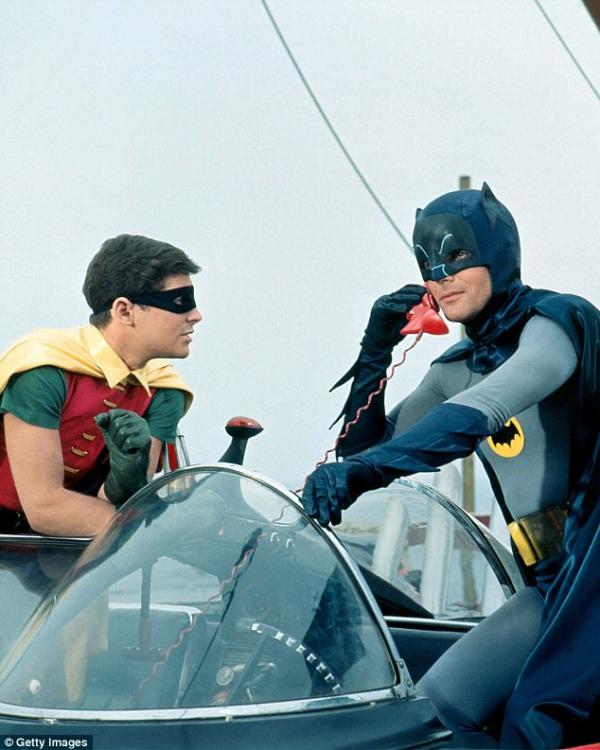
kscarbel2
Moderator-
Posts
18,935 -
Joined
-
Days Won
114
Content Type
Profiles
Forums
Gallery
Events
Blogs
BMT Wiki
Collections
Store
Everything posted by kscarbel2
-
Sacramento to Run Electric Garbage Truck on Regular Routes
kscarbel2 replied to kscarbel2's topic in Trucking News
Sacramento orders refuse truck with Motiv electric powertrain Fleet Owner / June 13, 2017 Sacramento joins Chicago as the only ones in North America with an all-electric model. Motiv Power Systems said Sacramento, CA, has become the second city in North America to order an electric refuse vehicle (ERV). Sacramento’s Class 8 ERV will use Motiv’s all-electric powertrain, saving the city 6,000 gallons of fuel a year. It will come equipped with 10 battery packs and be expandable to 12 packs. The ERV is built on a Crane Carrier chassis and Loadmaster body. Chicago has already put one automated left-side loader ERV into service. “Reducing harmful vehicle emissions in the Sacramento region is a primary focus of our sustainability policy, and the most effective way to achieve that goal is to implement electric vehicles into our fleet,” said Mark Stevens, fleet manager for Sacramento. “The city of Sacramento intends to prove that all-electric refuse trucks are the future of the industry, and we anticipate igniting that trend.” “Reducing the amount of diesel-fueled refuse trucks in the city keeps communities safer from toxic diesel emissions. And, in addition to being cleaner, it’s a quieter alternative to conventional trucks - a definite plus for those of us who appreciate peaceful mornings,” said Motiv CEO Jim Castelaz. Motiv said its electric powertrain uses off-the-shelf batteries and motors, which can be mixed and matched to fit the exact size and duty cycle needed. It can be assembled using the existing diesel chassis infrastructure already established throughout the world. -
The Electronic Logging Device (ELD) Controversy
kscarbel2 replied to kscarbel2's topic in Trucking News
UPS seeks technical exemptions from ELD mandate Fleet Owner / June 12, 2017 UPS says requests would save money without hurting safety. United Parcel Service (UPS) has asked the Federal Motor Carrier Safety Administration (FMCSA) for technical exemptions to the electronic logging mandate scheduled for implementation in December. The company said the requests would save money while not having any negative effect on highway safety. FMCSA is accepting public comment on the requests until July 10. First, the Atlanta-based company is asking for a tweak to the timetable for fleets using compliant automatic on-board recording devices (AOBRDs). They can legally be used until December 2019, if already installed on a vehicle. UPS said the decision to permit "grandfathering" only on a vehicle, and not a fleet-wide, basis is problematic as it moves forward with plans to purchase new trucks and complete a transition to electronic logging devices (ELDs) on a site-by-site basis. “If no temporary exemption were granted, large carriers would be required to use ELDs in all of the new tractors delivered after Dec. 18. 2017. The result would be that UPS facilities that had not been converted as of that date would have both vehicles using ELDs at the same time,” the company said. In order to more easily complete the transition, UPS has requested approval to allow the installation of AOBRDs on new trucks delivered after December, while also ensuring all vehicles will be fully ELD-compliant by the December 2019 deadline. UPS also is seeking an exemption from the requirement that ELDs automatically record data when a driver indicates a change of duty status, and when an authorized user logs into or out of an ELD. UPS said as part of its agreement with the Teamsters union, drivers use electronic devices to record work beyond driving, which could include attending safety meetings or training. “UPS cannot both comply with the requirement that an ELD record tractor data when a driver logs in or out (or otherwise changes duty status while outside of the vehicle) and also comply with our bargaining unit contract and pay guidelines for our drivers” the company said. In addition, UPS requested a temporary exemption for a special driving mode for yard moves that will not require a driver to repeatedly indicate that status. “The ELD rule would require drivers to manually change duty status twice for every move they complete in the yard, which could mean entering manual changes as many as 20 times in an hour,” UPS said. The carrier said approval of an exemption to remain in yard move status under specific speed and geo-fence parameters, it could save could save more than $450,000 with no safety downside. Finally, UPS is seeking an alteration to the requirement an ELD automatically record data when the engine is powered up or powered down. The company said it uses 1,434 people to wash or fuel vehicles, who often move commercial vehicles strictly within UPS yards. “Therefore, insofar as the ELD regulations would require recordation of engine data for in yard operation of UPS vehicles by non-driver employees, that requirement would impose a significant burden on UPS. While it would be possible to provide these employees with portable ELDs to record engine data, doing so would be extremely costly,” the company said. It estimates the cost would top $1 million dollars, and it is seeking an alternative approach to track vehicle usage by wash and fuel employees on company property, such as exempting vehicle usage when travel is less than 1 mile. -
Jason Cannon, Commercial Carrier Journal (CCJ) / June 13, 2017 The pending tidal wave of electric trucks that may or may not ever see the highway presents a unique set of challenges for tire makers: Torque management. In an interview with CCJ during the company’s global summit for sustainable mobility in Montreal Tuesday afternoon, Michelin Americas Truck Tires Chief Operating Officer Ralph Dimenna said innovations in trucking have will have an impact on suppliers from the bumper to the underride guard. “I’m positive the [electric truck] movement will have an impact on tires of the future,” he says of electric motors that can more than double the amount of torque of their diesel counterparts. “Do you change [tire] sizes? Do you change the rubber compounds? Do you tune the [electric motor] down? You try and work through all that.” Thanks to its deep ties to passenger cars, Michelin has experience with the gold standard of electric mobility: Tesla, who expects to debut an electric tractor in three months. “This is a totally different application,” Dimenna says of the electric semi, “but we have that internal knowledge that we can carry over.” The challenge comes, he says, in striking a balance for fleets that offers the right amount of green energy without driving up their cost of ownership. “There’s a lot emotion and passion on the car side of the business in terms of how you feel when you drive a Tesla,” he says. “We’re still, on the truck side, very much on the functional [side].” Tesla’s cars, in general, offer a limited range, but owners – drawn in by eliminating the car’s carbon footprint and sleek design – see mileage limitations as an acceptable trade-off. Truck owners, Dimenna says, will be far less likely to embrace a similar sacrifice. “On the truck side, we’re still trying to figure out what that ‘no sacrifice’ looks like,” he says. “People who are driving these trucks are depending on these vehicles everyday to deliver freight.”
-
Sacramento to Run Electric Garbage Truck on Regular Routes
kscarbel2 posted a topic in Trucking News
Heavy Duty Trucking / June 13, 2017 The City of Sacramento, California, says it will run one of the first all-electric garbage trucks on regular routes in the area. The automated left side loader garbage truck features a Motiv Power Systems all-electric powertrain, built on a Crane Carrier chassis with a body built by Loadmaster. The city plans to run the truck on residential and recycling routes throughout the city. Sacramento specified that the truck must be able to meet the same demands placed on all of its garbage trucks, including running three routes per day to remove trash, recycling, and green waste in a downtown neighborhood. “Reducing harmful vehicle emissions in the Sacramento region is a primary focus of our sustainability policy, and the most effective way to achieve that goal is to implement electric vehicles into our fleet," said Mark Stevens, fleet manager for Sacramento. “The City of Sacramento intends to prove that all-electric refuse trucks are the future of the industry, and we anticipate igniting that trend." The truck is equipped with 10 battery packs, expandable to 12 packs for future route expansion. Using Motiv’s Universal High Power Charger, the vehicle’s batteries will reach full charge overnight. Sacramento expects to save as much as 6,000 gallons of fuel per year, with the electric truck replacing a conventional diesel refuse truck that averages 2.8 mpg. Motiv's All-Electric Powertrain uses off-the-shelf batteries and motors, which can be mixed and matched to fit the exact size and duty cycle of the electric truck needed. It can handle EV trucks from medium-duty to heavy-duty, weighing 14,000 pounds to 60,000 pounds, according to Motiv. The All-Electric Powertrain is designed to be assembled using existing diesel chassis infrastructure. "The value of the City of Sacramento's zero-emission ERV goes beyond lower fuel and maintenance cost and strict payback," said Jim Castelaz, Motiv chief operating officer. "Reducing the amount of diesel-fueled refuse trucks in the city keeps communities safer from toxic diesel emissions.” . -
Navistar Defense Lands $18.8M Contract for Medium Tactical Vehicles Heavy Duty Trucking / June 13, 2017 The U.S. Army recently awarded Navistar Defense an $18.8 million foreign military sales contract to provide 115 International 7000-MV Medium Tactical Vehicles to Iraq. Navistar Defense MTVs are based on the multipurpose International WorkStar severe-duty platform designed for both on- and off-road operation. The vehicle also provides the platform for the company’s MaxxPro Mine Resistant Ambush Protected Vehicle. The equipment will be used by Iraqi security forces in the Ministry of Interior and Ministry of Defense. Navistar Defense’s dealer in Iraq, Hama, provides parts and service support for Navistar vehicles in the region. The vehicles will be built at Navistar Defense’s West Point, Mississippi, assembly plant and delivery is expected to be completed in January 2018. "Since 2004, Navistar Defense has delivered nearly 7,000 trucks and buses to Iraq through foreign military sales contracts," said Kevin Thomas, president of Navistar Defense. "As a proven partner, we're proud to supply the Iraq Army with a highly versatile and easy-to-maintain 7000-series tactical military support truck that offers greater efficiencies in support, spare parts, training, and operations." .
-
Critics push U.S. to help Europe by taking more refugees
kscarbel2 replied to kscarbel2's topic in Odds and Ends
-
Fiat Chrysler diesels spew excess pollution, VW sleuths report Bloomberg / June 13, 2017 West Virginia researchers shed new light on FCA cheating allegations WASHINGTON -- Fiat Chrysler diesel vehicles spewed pollution as much as 20 times the legal limit, according to testing by the same researchers who first recorded the excess emissions in Volkswagen AG’s diesel cheating scandal. The revelation from a West Virginia University laboratory sheds new light on the U.S. Justice Department’s allegations in a civil lawsuit last month that Fiat Chrysler Automobiles has used illegal "defeat devices," software that helps evade emissions tests. It comes amid growing concerns about the ability of diesel engines to satisfy U.S. emissions limits and the extent to which automakers may be working to navigate around them. The West Virginia University’s Center for Alternative Fuels, Engines and Emissions stopped short of accusing Fiat Chrysler of emissions cheating, but said on-road tests of Jeep Grand Cherokee SUVs and Ram 1500 pickups revealed nitrogen oxide levels at three to 20 times what is permitted by U.S. clean-air rules. Nitrogen oxide, or NOx, can cause smog and acid rain. "We saw emissions results in simulated on-road cycles on chassis dynamometers that were much lower than the actual on-road results were, suggesting that the vehicle was controlled in different fashions," said Daniel Carder, director of the center. The researchers tested five of the Jeep and Ram models from model years 2014-2015 in laboratories and on the road and using portable equipment to measure emissions. The vehicles emitted NOx levels during on-road tests in excess of U.S. limits. The on-road NOx emissions were also higher than observed in laboratory tests designed to replicate the driving maneuvers in the on-road tests. Fiat Chrysler, in a statement, said it has asked for more information about how the study was conducted but "this testing appears to have been commissioned by a plaintiffs’ law firm for purposes of litigation." Carder declined to comment on who commissioned the research. 'No regulatory protocol' U.S. pollution standards for emissions are based on laboratory testing, so a comparison with on-the-road tests is "invalid," the company said. The researchers’ appear to have obtained some of the results by driving faster and with more weight in the vehicle than the regulators call for, according to the statement. "Despite the report, there is no regulatory protocol for conducting on-road emissions testing," the company said. Carder acknowledged that some of the on-road tests were more demanding than U.S. laboratory procedures, such as a test route on a steep ascending road. However, Carder said, "we were seeing elevated NOx levels even on the ascent, which is something we wouldn’t expect." In its civil lawsuit against Fiat, the U.S. argues that any undisclosed software is illegal and that features within the automaker’s emissions control systems were designed to evade emissions tests. The case focuses on diesel engines in Jeep Grand Cherokee SUVs and Ram 1500 pickups for model years 2014 to 2016, alleging that they generate more emissions in normal driving than during laboratory tests. Fiat Chrysler CEO Sergio Marchionne has said the automaker never set out to cheat emissions tests. And in a statement last month, the carmaker said it intends to vigorously defend itself "particularly against any claims that the company engaged in any deliberate scheme to install defeat devices to cheat U.S. emissions tests." Separately, General Motors was sued May 25 for allegedly putting defeat devices in two models of heavy-duty trucks from 2011 to 2016. The class-action suit by owners or lessees of more than 705,000 GM Duramax diesel trucks argues that the vehicles passed U.S. inspections despite spewing emissions two to five times the legal limit. Central role The West Virginia center that conducted the recent Fiat Chrysler tests has played a central role in emissions cheating scandals before, having documented outsize emissions as much as 35 times what was expected during testing of Volkswagen vehicles in 2013. Those tests were commissioned by the not-for-profit International Council on Clean Transportation, a group that works closely with regulators worldwide, and helped drive later lawsuits against Volkswagen. In the Volkswagen tests, the center monitored emissions by driving vehicles while portable measuring equipment was attached via hoses to their exhaust pipes. Carder declined to discuss other diesel vehicles tested by the West Virginia University lab. Volkswagen admitted in 2015 that about 11 million diesel cars worldwide were outfitted with so-called defeat devices. A U.S. judge on May 11 approved a $1.225 billion settlement between the German automaker and regulators and will buy back or repair some 560,000 vehicles. It’s a difficult burden of proof for government and plaintiffs in the FCA lawsuit to "really come up with a smoking gun piece of evidence -- ‘smoking’ the key word here -- that there was in fact intent to cheat the testing for emissions," said Richard Hilgert of Morningstar, who has a buy rating on Fiat Chrysler. "This is a negotiation," Hilgert said. "We’re going to see some kind of settlement at some point." Carder said in a telephone interview that finding a "smoking gun" is not the objective of his lab’s diesel tests. "Our intent is to look at how these emissions controls systems are performing in the real world," Carder said. "We think that’s where it really matters."
-
Diesel News AU / June 2017 It is fair to say International has had a chequered history in Australia for the past thirty years or so. However, this year it is all back on track with the launch of the new Prostar trucks. Back in the nineties, two brands dominated the truck market at the heavier end – Ford and International. However stability was lost back then, when the International Harvester company went into administration and then managed to trade its way out of the situation. This left International Trucks as an independent standalone brand, which was taken over by Iveco in Australia in the 1990s. The company was still a big player in the market and models like the ubiquitous S-Line still predominated, alongside the long-lasting Acco. Then the International brand seemed to fade away as it merged into Iveco. At the same time, the International Trucks global owner, Navistar, was concentrating on its core market in North America, a famously cyclical market. A few years later, International was back in Australia in a deal between Iveco and Navistar. International Eagle 7900 models along with 7800s and, later, 7600s were assembled in Dandenong in Victoria and kept the brand alive for another few years. Financial woes for Navistar in the US saw the company walk away from its overseas commitments to concentrate on simply surviving as a financially sound entity. After a number of close calls, the new Navistar came out leaner and meaner and got back into a strong position in the US market, competing on an equal footing with Freightliner, Kenworth et al. One of the strong points in the Navistar revival was the ProStar model which has been highly successful on the US market as its aerodynamic fuel saving appealed to the US truck buyer. We saw this model appear as the Cat prime mover in Australia, over five years ago, only to fade away from the market over the following few years. Well, now its back, this time as an International ProStar, and as part of the offering from Iveco to the Australian truck market. Existing Iveco dealers, and some others, are lining up to put examples of the new trucks in their showrooms and give the International brand a chance to re-emerge onto the Australian truck market with some presence and credibility. It’s two years since the intention of International to return to Australia was announced with a major stand at the Brisbane Truck Show displaying both the ProStar and the iconic and eye-catching LoneStar. The negotiating process between Navistar in Chicago and CNH, the owner of the Iveco, in Australia, was a long and involved one. Both are major global companies, who have a history of good, and not so good, deals between them. It has taken nearly two years for the stars to align, and now we have the two organisations working together to launch the new trucks in Australia. The re-entry of International looks like being a relatively low key one. The truck models available in the first offering are a modest four in number and the number of options available to buyers are minimal. This is clearly intended as a first step in the door, aimed at specific market segments. Once established the International Truck team will be able to look at the next stage, introducing further options and, perhaps, other models. .
-
Trade Trucks AU / June 9, 2017 Notice affects Mack Trident, Super-Liner and Titan models The Australian Competition and Consumer Commission (ACCC) has issued a recall of 617 Mack trucks manufactured between August 10, 2015 and September 16, 2016. The recall affects Mack Trident, Super-Liner and Titan models. "The cab power and ground cable terminals (eyelets) may crack and eventually fail where the terminal attaches to the cab pass through plate," the ACCC notice states. As a result, the vehicles can possibly lose power and thus become immobile, posing a potential safety risk for the occupants or other road users. Volvo Group Australia to contact affected owners by direct mail. Owners are advised to call their closest authorised repair dealer to book an inspection as soon as possible. The full list of vehicle identification numbers affected by this recall can be found here.
-
Power Torque Magazine / June 2017 Building relationships in the transport business is a cornerstone of any successful enterprise, not only with customers but also with your suppliers. In Bruno Simone’s case, good relationships with clients, suppliers and staff of City Crane Trucks has been critical in establishing the Adelaide-based business as a leader in its field since it started in 1999. Having started the business on the back of a well-used Hino traytop truck – previously used for carting fruit and vegetables – a crane was installed, and so began the crane truck business. Nearly two decades later the City Crane Trucks fleet now numbers more than 30 vehicles, with two Freightliner Argosy crane trucks among half a dozen Freightliners within the company’s fleet that also has Volvo, Isuzu, Iveco and DAF representatives. Currently, the City Crane Trucks largest unit is a DAF CF85 fitted with a Hiab 800E7 crane, which it claims is currently the largest crane truck in Australia – Mr. Simone said when fully extended to 28 metres it can pick up 1 tonne, or 15 tonnes can be hoisted at a range of 4 metres. “The DAF is our biggest, while the smallest truck can go 14 metres and pick up 500 kilograms, or at 3 metres it can lift 4 tonnes – we have 30 cranes and it’s a big variety”. There’s no element of complacency in the City Crane Trucks boss, who is planning to add to the Argosy population of the fleet next year, testimony to the breed’s performance for the company. “The DAF’s crane next year is coming off and going on a twin-steer Argosy, that’s next year’s project, we regularly upgrade as many as four trucks a year,” he said. The crane changeover follows almost two years of solid service from the latest Argosy to join his fleet – “that’s been on the road for almost two years. It’s pretty busy all the time – we use the Freightliner Argosy and Columbias for our bigger 30-tonne cranes”. “That Argosy is a 10-year commitment, the smaller ones are 5 to 7 years, the Argosy’s crane is relatively small, but it’s an expensive piece of equipment,” he said, while not wishing to disclose beyond “six figures” exactly how much one of the rigs would cost to purchase and fit out. The fleet numbers just over 30 trucks – the majority being prime movers and a handful of rigid trucks – including an Argosy Cat C15 with a Palfinger PK73 crane. Mr. Simone said the more recent Argosy – a twin-turbo DD15 twin-steer 8×4 90-inch mid-roof with an 18-speed auto and Palfinger PK63002 crane – was also well suited to crane applications. “It’s a good truck, it’s lived up to expectations….we pick our trucks mainly for weight distribution, and the Argosy has good steer weight, good tare weight. Obviously the support we get as well from the manufacturer, again, it’s a relationship thing,” he said. The company looks after its equipment on site, performing all its own trailer maintenance as well as intermediate servicing. This is particularly relevant given the number of idling hours completed while undertaking the crane side of the vehicle duties, with the trucks receiving workshop attention on-site and at dealers when diagnostic work is required. The City Crane Truck fleet now also includes an all-terrain fork truck, the result being a fleet of crane trucks suited to a wide variety of tasks. Work requirements can be extremely varied, ranging from the installation and retrieval of the Clipsal 500 racetrack concrete barriers and site huts, as well as transporting household products, timber trusses, bricks, Gyprock, lawn, safes, windows, septic tanks, concrete pits, pools and large rocks – even fake crocodiles for restaurant chain Outback Jack’s. “Whatever we can pick up, deliver and install, we’ll do it, we deliver pools, hoist them over the house, we’ve done marble benchtops, pianos, furniture, anything,” Mr. Simone said. Although based in Adelaide, the trucks are involved in intra and interstate transport of loads ranging from the conventional to the less common. A few minutes on the company’s new-look website or its Facebook page picture gallery is evidence of the varied loads it has been tasked with transporting. The famous “Malls Balls” – a prominent double-sphere sculpture and a staple feature of the Adelaide CBD’s Rundle Mall shopping precinct – were removed when major works were undertaken in the mall. The City Crane Trucks crew were trusted with the task. City Crane Trucks is a family-owned and operated business employing around 40 staff, with Bruno’s wife running the accounts and his brother in the role of general manager. Mr. Simone said business was good, but the biggest problem is finding qualified driver/crane operators – he gestures at several trucks in the yard that are in need of operators. “We can grow, but to do so you need the correct people and our struggle is to find the right operators for the cranes”. “That’s our struggle, to find the people to make it happen, we’re busy but there are a few trucks parked out there because we can’t get operators for them,” he said. A genuine family business, the management looks to keep its workforce (many of whom are long-term employees) happy and motivated with social events, as well as offering a bonus system to reward staff who put in extra effort. “You get the right people in, they work hard and they’re paid well for it, they’re here for 12 hours a day sometimes,” he said. “Our guys get the award rate and penalties, but we work on a bonus system, the more you put in the more you get back out, it works for about a third of our 30-odd drivers who see the opportunity and take it up,” Mr. Simone said. “Staffing is the biggest problem in this industry, not the drivers but the crane operating side. I can get drivers, but not many can operate a crane, there’s a lot of procedures and OHS to it before they are able to become proficient,” he said. Mr. Simone said the business was well established and had thrived in the boom times and weathered the tougher times. “An old fella told me once, if you’ve got a business that won’t run without you, you don’t have a business, you have a job. You need to build a business that operates without needing you there, it comes back to the people,” he said. “As long as we stick to the budget and keep moving forward – we’ve done our hard times, we own the land and it’s a bit easier now, it would be hard for someone trying to start today,” added Bruno. DETAILS The Freightliner Argosy is available in 6×4 and 8 x4 configuration powered by either the Detroit DD15 in ratings of 500-560 hp with 1850 lb-ft of torque or the Cummins X15 in ratings of 485-600 hp and with torque ratings of 1850 -2050 lb-ft. Transmission options include the Eaton Roadranger manual or UltraShift Plus AMT. In an 8×4 application the Argosy is only available with a 90-inch cab, but in prime mover form the cab options include a 90-inch, 101-inch and 110-inch mid-roof sleeper, plus a 110-inch raised-roof sleeper cab. Axle choices range from parabolic front taper leaf spring suspensions with Daimler or Meritor axles together with Meritor rear axles and Freightliner AirLiner, Hendrickson PRIMAAX and Neway AD-246 air suspensions or the Freightliner TufTrac six-rod steel spring suspension with ratings from 106-140 tonnes GCM. Roll stability control, traction control and ABS safety systems are by Wabco, and Bendix disc brakes are available when specified with the Daimler front axle package. .
-
Transport Engineer / June 8, 2017 Wincanton is taking delivery of 100 Renault Range T tractors – its largest order to date for the vehicle – after positive performance from previous Range Ts in its fleet. The new 6x2 additions comprise 75 of the 11-litre Range T460 model and 25 of the 13-litre T480s. They began entering service last month and are working across Wincanton’s construction and general haulage contracts. Efficiency, reliability and safety were the key selection criteria. “We’ve been impressed by the existing Range Ts on our fleet, which are delivering strong operating performance with excellent fuel economy,” confirms Carl Hanson, Wincanton’s group fleet director. “The latest vehicles are highly specified with advanced technologies that promote more fuel-efficient driving and safeguard our drivers, their load and other road users, while increasing productivity and fleet utilisation.” The new Range Ts come with Renault’s Optifleet Fuel Eco+ Pack, including Optivision which uses road topography to optimise gear shifting and improve fuel economy. The construction vehicles are also fitted with Kuda LaserEye truck spoiler automatic adjustment system, which sets the optimum spoiler height and angle for every trip, providing further fuel savings. For added safety, the trucks are also equipped with lane departure warning system, automatic emergency braking and adaptive cruise control. The vehicles are supplied on a three-year operating lease through Renault Trucks Financial Services. They will be maintained by Pullman Fleet, part of the Wincanton Group. .
-
Sean Kilcarr, Fleet Owner / June 12, 2017 On the surface, SuperTruck projects might seem like a waste of time and money. But they are helping OEMs make their everyday commercial products more fuel efficient. In mid-2016, the u.s. dept. of energy (DOE) announced that it would fund a second heavy-truck research and development project, dubbed SuperTruck II, to the tune of $80 million. And many fleet managers might’ve rightly rolled their eyes, wondering whether such government expenditures ever result in real-world benefits for trucking companies. Then you talk with someone like Wade Long, director of product marketing for Volvo Trucks North America (VTNA), who has been intimately involved with such research projects, and you get a whole new perspective on the potential fuel economy benefits of such programs. During a panel discussion at the annual Technology & Maintenance Council (TMC) convention earlier this year, Long discussed some of the outcomes VTNA achieved from its participation in the SuperTruck I initiative. Launched in 2010, that program focused on efforts to improve tractor-trailer fuel, engine and drivetrain efficiency through the use of various “advanced technologies” such as improved aerodynamic designs, waste heat recovery systems, and the like. Long noted that VTNA’s Super Truck project got an average of 12 mpg compared to 7 mpg gained by a 2009 model Volvo VNL tractor and standard trailer used as a “baseline” for comparative measurement. That difference of 5 mpg might not seem like much, but it translates into about $17,000 worth of fuel savings per truck per year, he emphasized. That’s more than enough to offset the predicted direct costs of the Phase 2 greenhouse gas (GHG) rules, which are aimed at improved fuel economy for Class 8 tractors and trailers. The Environmental Protection Agency (EPA) estimates the costs will be as follows: upfront price increases of some $11,700 for tractors, $1,200 for trailers, $3,400 for vocational vehicles, and $1,300 for pickups/vans. Now, not all the technologies and tweaks deployed for the SuperTrucks can be directly transitioned onto commercial vehicles operating in the real world. Yet in many ways, they are the “test beds” upon which OEMs determine whether fuel-saving improvements make the grade in terms of practicality, payback, reliability, etc. For example, Long noted that VTNA started making changes to its 2016 models based on its SuperTruck work (that began in 2011), revising bumper fairings, chassis fairings, and roof fairing shapes. Jeff Girbach, manager of engine technologies for Daimler Trucks North America (DTNA), also participated in the TMC panel discussion. He added that SuperTruck projects allow OEMs to pursue what he calls “high risk, high reward” technologies. He also noted that these projects often find that certain technologies can deliver more fuel savings in combination rather than individually, leading to what he calls “1+1+3” effects. “These projects are showing us that in terms of fuel efficiency, a truck can be more than the sum of its parts,” he explained. Girbach noted that one of the biggest findings DTNA made from its SuperTruck work—one it’s applying to its new 2018 Freightliner Cascadia as well as other truck models—is that allowing a highway tractor to “coast” in neutral, letting the momentum of the vehicle maintain it at highway speed while allowing the engine fall to idle, can deliver bigger than anticipated fuel savings. DTNA received $40 million—out of a total agency allotment of $115 million—from the DOE to develop its first SuperTruck combination vehicle seven years ago and will get $20 million as part of the SuperTruck II program. DTNA’s SuperTruck I vehicle demonstrated a more than 50% improvement in overall freight efficiency and a 50% increase in engine brake thermal efficiency, or BTE, compared to a 2007 model-year tractor-trailer used as a baseline for the project. The OEM’s prototype vehicle operated on two different on-highway routes in Oregon and Texas, recording a 52% and 61% increase in fuel improvement, respectively, in part because the SuperTruck tractor-trailer weighed in at 1,500 lbs. less than the baseline combination unit. On top of that, many of the concepts used on DTNA’s SuperTruck platform, such as an integrated powertrain, 6x2 tractor axle optimization, and enhanced aerodynamics, became real-world components. New technologies such as a downsized engine coupled with a hybrid electric powertrain, along with a waste heat recovery system, provided a further fuel efficiency boost. “At the end of the day, we’re trying to create the most efficient Class 8 chassis in the world,” Girbach explained. Charles Chilton, Navistar’s director of product development, emphasized during TMC’s panel discussion that the “real trick” to transitioning the fuel efficiency improvements achieved by SuperTruck projects—ones like his company’s CatalIST combination vehicle—to “real-world” tractor models is to achieve “commercially viable” payback in a one- to two-year timeframe. The last three letters of the CatalIST stand for “International SuperTruck,” referencing the company’s International commercial track brand name. The vehicle is connected to a Wabash-built trailer and achieves 13 mpg, improving “freight efficiency” by some 104% compared to the 2009 model tractor used as the baseline for the project. The vehicle also demonstrated a 50.3% BTE improvement, while establishing a “path,” in Chilton’s words, toward achieving a 55% improvement in BTE. Navistar’s predictive cruise control technology is an example of a significant technical innovation the company achieved through the program. Chilton said predictive cruise control looks ahead of the vehicle and recognizes the terrain and continuously calculates the most efficient speed and gear for optimal fuel economy in real time. Unlike conventional predictive cruise technology, the company’s predictive cruise control uses pre-installed GPS maps and the latest commercial route data to make adjustments to cruising speed without the need to pre-drive the route. Other improvements fostered by the CatalIST included: ◗ A hybrid front suspension and lightweight rear suspension that leverages lightweight alloys with composite materials, reducing weight and enabling an electronic ride height management system, which provides dynamic ride height and pitch control for improved aerodynamics. ◗ Aerodynamic improvements that reduce the trailer’s drag coefficient by more than 30%. Chilton added that the CatalIST truck can sustain 65 mph on the highway with just 80 engine horsepower. He also noted that the vehicle’s BTE improvements come from two distinct areas: two-thirds from the combined aerodynamics of the tractor-trailer and one-third from “system efficiencies” such as a reduction of parasitic loads on the engine. Ken Damon, manager of vehicle performance for Peterbilt Motors Co., noted during his presentation at TMC that Peterbilt, engine maker Cummins and Eaton Corp. collaborated on a SuperTruck I project that also looped in TL carrier U.S. Xpress in order to keep “the voice of the customer” front and center during all of the research. “We needed their input to decide what could become commercially viable and what could not,” he stressed. In 2015 after Peterbilt initially completed its SuperTruck I project, Damon explained to Fleet Owner that the “test vehicles” represent “great examples of several things working together—optimizing components and systems, enhancing aerodynamic efficiencies, and maximizing operator performance.” During testing, he said Peterbilt’s SuperTruck I vehicle—loaded out to 80,000 lbs.—achieved an average fuel economy of 10.4 mpg. And while Damon stressed that drivers will “always be essential to vehicle operation and fuel efficiency, automation does help immensely.” Using technologies like predictive cruise control has a significant impact on fuel economy, as the vehicle optimizes acceleration, coasting and braking based on terrain, such as road inclines, far ahead of what the driver can anticipate, he explained. The Cummins/Eaton/Peterbilt SuperTruck program combined a more efficient diesel engine, an advanced waste heat recovery system, an aerodynamic Peterbilt tractor and trailer combination, and a lithium ion battery-based auxiliary power unit to reduce overnight engine idling that in some cases helped the vehicle attain 10.7 mpg. Yet attaining and sustaining such numbers in real-world work environments remains difficult, Damon said. “Miles per gallon will always be duty-cycle dependent, and the transient nature of these duty cycles makes it difficult to state if certain fuel economy values will be able to be reached and maintained in specific environments,” he said. Near term, Damon emphasized that the focus will be on convincing fleets to alter their truck and trailer specs to gain a more fuel-efficient footprint. “Sometimes, out of habit or misconception, customers will still want to spec the largest engine with the most horsepower. That results in more weight and more fuel cost,” he explained. “After they realize they can get the job done just as well with a smaller-block engine, they never look back.” Damon added that, like most truck OEMs, Peterbilt is continuing to develop “optimized spec packages” to not only deliver vehicles finely tuned for fuel efficiency to the best their application will allow but to simplify the ordering process for customers as well. In 2014, the OEM introduced APEX, an optimized powertrain that pairs the Paccar MX-13 engine with Eaton’s Fuller Advantage AMT. The combination features optimized shift calibration, weight savings, and proprietary control logic that result in up to a 4% improvement in fuel efficiency. Another new Peterbilt package that came out of the SuperTruck I effort is the Model 579 EPIQ, which can improve fuel efficiency by up to 14%, Damon said. The package combines APEX with a full range of aerodynamic add-ons and “closeouts” around the wheels, low rolling resistance tires, and other fuel-saving technologies. Additionally, the ability to recover and store more energy via waste heat recovery systems that were tested in the SuperTruck are now being evaluated for real-world deployment. “Adoption of waste heat recovery technology— the process of utilizing the excess heat generated from the engine as useful energy—will be a function of customer expectations, duty-cycle requirements, and payback,” he explained. “Yet it is a technology that has the potential to be key in delivering fuel efficiency gains in the future.” Thus the whole point of such programs, Damon stressed, is to bring a “broad cascade of technology” to current products that was not previously possible yet keep them “economically viable” at the same time. Vivek Sujan, director of product innovation at Cummins Inc., also sounded that “feasibility theme” during the panel discussion because the engine maker used its work on the SuperTruck I program to jump-start development of its new X15 line of heavy-duty engines. “Looking at the [fuel economy] issue from the ground up in this program was a real eye-opener here,” he said. “It allowed us to perform a more ‘holistic’ analysis in terms of designing an engine to work within an entire system.” That research also helped the company decide on a “differentiation’ strategy when it came to the new X15 engine family. For example, the 15-liter X15 Efficiency Series is “tuned” to provide maximum fuel economy, delivering 3% better fuel economy versus 2016 equivalent models and an over 10% improvement versus 2010 equivalent displacements. By contrast, the 15-liter X15 Performance Series is focused on providing more power, especially for heavy loads. Those particular engines are rated between 485 and 605 hp. and deliver 1,650 to 2,050 lbs.-ft. of torque. VTNA’s SuperTruck demonstrator, unveiled late last year, also worked to bring numerous prototype features into real-world operation on its current line of tractors—everything from top-of-cab solar panels powering the vehicle’s battery and interior lights, to its ultra-light aluminum frame and retooled 425 hp. 11-liter proprietary engine. VTNA said its SuperTruck tractor-trailer combination boosted fuel efficiency by 70%—exceeding 12 mpg, with some test runs showing more than 13 mpg, noted Long—in road tests, with BTE reaching 50%. In terms of differences when compared to current models, VTNA’s SuperTruck unit has a shorter front end than conventional trucks on the road today, with the hood featuring a sharper downward slope. Lightweight fairings run the length of the tractor and trailer, and cameras have replaced rear view mirrors. The redesigned chassis is made almost entirely of aluminum, which cut the chassis weight in half, helping slice 3,200 lbs. out of the overall weight of the tractor-trailer. Once again, automated technology plays a role in attaining fuel efficiency gains with an enhanced version of Volvo’s I-See, a new feature for the OEM’s proprietary I-Shift AMT. I-See memorizes thousands of routes and then uses that knowledge to optimize cruise speed and keep the AMT on board VTNA’s SuperTruck in the most fuel-efficient gear possible. So, did any of those “advances” make it into Volvo’s “real-world” trucks? Three engine advancements developed through SuperTruck research did—the wave piston, turbo compounding system, and common rail fuel injection system. They are now integral parts of the OEM’s 2017 engine lineup. Likewise, a number of VTNA SuperTruck-derived aerodynamic improvements are available for the company’s current VNL tractors. These include flared chassis fairings that improve air flow around the drive wheels, redesigned bumper, and turbulence-reducing deflectors. And even small “tweaks” can deliver incremental fuel savings, which are magnified for a fleet based on the number of trucks it operates as well as by the mileage it accrues. As an example, VTNA’s Long noted that revisions made to the bumper on the 2016 model VNL derived from SuperTruck research helped deliver a 0.5% to 0.7% improvement in fuel economy. “We also made changes to the chassis and roof fairing designs; subtle changes of less than an inch that help deliver better fuel economy,” he explained. When all the tweaks are added up, Long said a 2016 model VNL ended up getting 3.5% better fuel economy compared to a 2015 model, and a good portion of those savings were derived from a 42% reduction in aerodynamic drag. He added that the aforementioned 2017-model Volvo D11 and D13 engines, retooled with improvements gleaned from the OEM’s SuperTruck research, deliver between 2.2% to 6.5% better fuel efficiency compared to 2014-model units. “This is only the start,” Long stressed. “We see a lot of opportunity to make more changes.” .
-
Isuzu builds 40,000th gasoline N-Series truck Fleet Owner / June 12, 2017 Truck rolled off the line at the Spartan Motors plant in Charlotte, MI, which has been building the N-Series since April 2011. Isuzu Commercial Truck of America noted that its 40,000th gasoline-powered Isuzu N-Series truck rolled off the production line at the Spartan Motors assembly plant in Charlotte, MI, back on June 8 this year. Assembly of Isuzu N-Series gas trucks began at the Spartan facility back in April 2011, the OEM noted. “From April 2015 to June 2016—a span of 15 months—we went from 20,000 to 30,000 gas-powered Isuzu trucks produced in Charlotte,” said Shaun Skinner, Isuzu’s president. “Now, only twelve months later, another 10,000 N-Series gas trucks have been built,” he added. “That’s a testament to the increasing popularity and growing reputation of our gasoline engine, low-cab-forward trucks.” Isuzu N-Series gas trucks are powered by a Vortec 6.0-liter small-block V8 engine that produces 297 hp at 4,300 rpm and generates 372 lbs.-ft. of torque at 4,000 rpm. It’s mated to a six-speed automatic transmission with double overdrive and lock-up torque converter for enhanced fuel economy and performance, the OEM said. An optional version of the engine is capable of being converted to run on compressed natural gas (CNG) or liquefied petroleum gas (LPG, or propane), Isuzu pointed out. Isuzu also markets diesel-powered N-Series trucks, the Reach Van powered by Isuzu and the all-new Class 6 FTR, which it launched last month, with the Reach and FTR models also assembled at the Spartan Motors plant in Michigan.
-
Heavy Duty Trucking / June 12, 2017 Isuzu Commercial Truck of America, Inc., distributor of low-cab-forward trucks, announced that the 40,000th gasoline-powered Isuzu N-Series truck has been produced at the Spartan Motors, Inc. facility in Charlotte, Mich. The truck rolled off the line June 8, 2017. “From April 2015 to June 2016 — a span of 15 months — we went from 20,000 to 30,000 gas-powered Isuzu trucks produced in Charlotte,” said Shaun Skinner, president of Isuzu Commercial Truck of America. “Now, only 12 months later, another 10,000 N-Series gas trucks have been built. That’s a testament to the increasing popularity and growing reputation of our gasoline engine, low-cab-forward trucks.” Assembly of Isuzu N-Series gasoline trucks began at Spartan in April 2011. Isuzu N-Series gasoline trucks are powered by a Vortec 6.0L small-block V8 engine that produces 297 hp at 4,300 rpm and generates 372 ft.-lbs. of torque at 4,000 rpm. The powerplant is mated to a 6-speed automatic transmission with double overdrive and lock-up torque converter for enhanced fuel economy and performance. An optional version of the engine is capable of being converted to run on compressed natural gas (CNG) or liquefied petroleum gas (LPG, or propane). A full range of gasoline-powered models is available: NPR (12,000-pound GVWR) Single Cab in wheelbases of 109, 132.5, 150 and 176 inches Crew Cab in wheelbases of 150 and 176 inches NPR-HD (14,500-pound GVWR) Single Cab in wheelbases of 109, 132.5, 150 and 176 inches Crew Cab in wheelbases of 150 and 176 inches Isuzu also markets diesel-powered N-Series trucks, the Reach Van powered by Isuzu and the all-new Class 6 FTR, launched last month. Reach and FTR are also assembled by Spartan Motors. “We offer the most complete line of low-cab-forward medium-duty trucks in the industry,” Skinner said. “The gasoline-powered NPR and NPR-HD are an important part of our lineup. So we expect to be reaching even more production milestones in the future.” .
-
The New Generation Scania V8 − Refined power for demanding operations
kscarbel2 replied to kscarbel2's topic in Trucking News
Scania introduces new generation of more fuel-efficient V8s; addressing needs of heavier, longer trucks Green Car Congress / June 12, 2017 Scania is introducing a new generation of Euro 6 V8 engines that represents Scania’s response to the growing trend in the transport industry towards heavier, longer trucks. The engines, which are available at 520, 580 and 650 horsepower, can reduce fuel consumption by 7 to 10 percent for customers with vehicles that have higher combined truck and trailer weights, higher average speeds, or both. The new V8 engine platform ranges from 520 to 650 hp; the current V8 engine platform will still be used for the 730 hp version Scania V8 engine. Each of the new V8s are characterized by advanced technical solutions that contribute to reduced weight, increased availability, and the 7-10% reduction in fuel consumption. The new V8 builds on many of the successful features from the earlier generations. But this time, out of approximately 650 components that make up the entire engine, 200 are completely new. The cross-functional team that developed the new V8 engine focused on four key areas: fuel efficiency to improve customers’ profitability, serviceability to increase the vehicles’ uptime, improved production processes to increase quality for even better robustness, and a contemporary design to match the New Generation Scania trucks. While the 16.4-liter cylinder block remains the same, the complete engine weighs approximately 80 kilograms (176 lbs) less than its predecessor. This is mainly due to a simplified engine layout with fewer parts overall—for example, the exhaust gas recirculation unit has now been removed. Consequently, the new V8 trucks have a higher load-carrying capacity. The new V8 engine meets emissions legislation together with decreased fuel consumption by increased aftertreatment efficiency. This has optimized the engine for fuel efficiency and power to a larger extent than when partly reducing emissions with exhaust gas recirculation (EGR) and conventional aftertreatment system. This also results in better engine breathing, which helps to improve fuel consumption. The new aftertreatment system includes improved evaporation, improved SCR catalysts (selective catalytic reduction) and an improved diesel particulate filter. The new aftertreatment system is an enabler for reaching Euro 6 emission levels without the need for an EGR. The new rotated twin scroll fixed geometry turbo is common in the racing industry, but this is its first use in the heavy vehicle industry. The fixed geometry increases efficiency and results in a 0.5% reduction in fuel consumption. The new turbo unit also allows for a higher boost pressure, resulting in improved combustion. The turbo unit also helps reduce the overall weight of the engine. The exhaust manifolds meet in the turbine housing from both sides instead of meeting in the turbo manifold, as they did in the previous generation, which was a more expensive and heavier solution. With the introduction of a single bank exhaust gas manifold, the overall weight of the engine has been reduced, while at the same time the V8 sound has been improved. The coolant pump utilizes a viscose coupling that is only engaged when needed. This results in adjustable cooling, which means that less coolant is pumped through the engine when it is not needed. Lower friction losses and the reduced energy used for pumping help to decrease fuel consumption by up to 0.5%. A new pilot-controlled oil pump adapts the oil pressure to the necessary amount at every moment. This helps to minimize the friction losses in the engine and results in a 0.5% reduction in fuel consumption. The introduction of an oil thermostat has reduced the fuel consumption between 0.5 and 1%. The thermostat provides faster oil-pressure build-up during cold starts and, more importantly, maintains an optimal oil temperature under normal operation. The Miller camshaft used in the new 520 hp V8 engine reduces airflow through the engine at low load. This in turn increases the exhaust temperature, which helps to reduce the fuel consumption by 0.5%. At high load, compression work is moved out from the engine to the turbo compressor. More energy is extracted from the exhaust gases, which increases engine efficiency. This is possible because the inlet port is held open for a longer time and the effective inlet stroke is shorter than the expansion stroke. This will over-expand the in-cylinder gases, with more power to the crankshaft for the same amount of fuel. A new clutch compressor engages automatically when needed. This helps to reduce fuel consumption by approximately 0.5%, while at the same time reducing noise emissions. Although the 730 hp V8 is still based on the current engine platform, it has not been left untouched. The updated 730 hp will, for example, feature the pilot-controlled oil pump, the variable water pump and the new larger aftertreatment system as well as an updated engine management system, which will improve its fuel efficiency—especially at low load. -
-
MACK filters
kscarbel2 replied to Lmackattack's topic in Antique and Classic Mack Trucks General Discussion
https://www.bigmacktrucks.com/topic/39995-filters/?hl=affinia#entry291618 -
It really is a small world.
-
-
Adam West dies aged 88 after short battle with leukemia The Daily Mail / June 10, 2017 Actor Adam West who portrayed Batman in the classic 1960s television series, died Friday night in Los Angeles. The actor passed away at the age of 88 after a short battle with leukemia and was surrounded by his wife, Marcelle, six children, five grandchildren and two great-grandchildren. After the ABC show died out, West struggled with being typecast and had a hard time finding consistent work until he got a job on the cartoon Family Guy in 2000. 'Our dad always saw himself as The Bright Knight and aspired to make a positive impact on his fans' lives. He was and always will be our hero,' his family said in a statement, according to the Hollywood Reporter. His family also posted to Facebook after his passing. 'It's with great sadness that we are sharing this news... Adam West passed away peacefully last night after a short but brave battle with leukemia,' his family wrote. 'He was a beloved father, husband, grandfather, and great-grandfather. There are no words to describe how much we'll miss him. 'We know you'll miss him too and we want you to know how much your love and support meant to him throughout the years. Hug your loved ones today.' Burt Ward, the Robin to West's Batman, said he was devastated by the loss of his close friend and co-star from the show. 'Adam and I had a special friendship for more than 50 years,' he said in a statement reported by Variety. 'We shared some of the most fun times of our lives together. Our families have deep love and respect for each other. 'This is a terribly unexpected loss of my lifelong friend. I will forever miss him. 'There are several fine actors who have portrayed Batman in films. In my eyes, there was only one real Batman that is and always will be Adam West. He was truly the Bright Night.' 'Stellar, exemplar, a king to the end,' Julie Newmar, who played Catwoman, said in a statement. 'He was bright, witty and fun to work with. I will miss him in the physical world and savor him always in the world of imagination and creativity. 'He meant so much to people. A friend said: "The father that we wanted." That is a great gift, no matter how you live it.' Seth MacFarlane, the creator of Family Guy posted a statement to Twitter about West's passing. 'Family Guy has lost its mayor, and I have lost a friend,' he wrote. 'Adam West was a joy to work with, and the kind of guy you always wanted to be around. 'His positivity, good nature and sense of fun were undeniable, and it was always a big jolt of the best kind of energy when he walked in to record the show. He knew comedy, and he knew humanity. 'I am beyond fortunate to have had the privilege of working with him and he will be profoundly missed by all of us. Thank you from the bottom of my heart for all that you have given, Mr Mayor. You're irreplaceable.' Comedian Seth Green who also worked with West on Family Guy said: 'He was a true hero of mine — grew up watching him as Batman, and got the privilege of both working with and directing him.' 'He’s generous and always classy. Very sad to think of the world without our beloved Mayor. How lucky we are he left so much behind.' West was born William West Anderson on September 19, 1928 in Walla Walla, Washington. He was the second of two sons. His father Otto was a wheat farmer and his mother Audrey was a pianist and opera singer. After his parents divorced, West, who was 15, moved to Seattle with his mother. He graduated from WhitmanCollege, a private liberal arts school, in Walla Walla. After serving in the Army, he went to Hollywood and took the stage name of Adam West. He began appearing on a number of television series, including 'Bonanza,' 'Perry Mason' and 'Bewitched.' He caught the attention of Batman's producer after he played a James Bond-type character in a commercial for Nestle. After reading the pilot script of the show, he said in a 2006 interview he 'knew after 20 pages that it was the kind of comedy I wanted to do'. 'You can’t play Batman in a serious, square-jawed, straight-ahead way without giving the audience the sense that there’s something behind that mask waiting to get out, that he’s a little crazed, he’s strange,' he said. After debuting on January 12, 1966, Batman was an immediate hit and was nominated for the Emmy Award for outstanding comedy series in its first year, though it lost to The Dick Van Dyke Show. A movie for the series was hurried into production and played in theaters ahead of the second season, which aired starting in September 1966. But after the show's third season, it lost popularity and Batman was canceled in March 1968. West's portrayal of Batman and his alter ego Bruce Wayne made it difficult for him to find consistent work after the show because of his association with the superhero. He initially chaffed at being typecast after Batman went off the air, but in later years he admitted he was pleased to have had a role in kicking off a big-budget film franchise by showing the character's wide appeal. 'You get terribly typecast playing a character like that,' he told The Associated Press in a 2014 interview. 'But in the overall, I'm delighted because my character became iconic and has opened a lot of doors in other ways, too.' West starred in a pilot episode of Lookwell, a show written by Conan O'Brien and Robert Smigel, but the show, about a former television detective who tried to solve crimes in real life, was never picked up. O'Brien posted to Twitter: 'Adam West gave probably the most inspired and ingenious performances in the history of television. 'He is revered by my generation of comic minds. He was also a sweet and lovely man, and it was a rare honor to know him.' West eventually landed a job in 2000, voicing a character on the cartoon Family Guy, as the mayor of Quahong, also named Adam West. But Batman was the role he would remain associated with throughout his life. The TV show was among the most popular in 1966, the year of its debut, and some of the era's top actors signed on to play villains. Burgess Meredith squawked as the Penguin. Eartha Kitt purred as Catwoman. And Cesar Romero cackled as the Joker. Years later, Michael Keaton, Val Kilmer, George Clooney, Christian Bale and Ben Affleck would don Bruce Wayne's camouflaging cape and cowl. West was married three times, and had six children. He had homes in Los Angeles and Palm Springs, but he and his wife, Marcelle, spent most of their time at their ranch near Sun Valley, Idaho. In April 2012, West received a star on the Hollywood Walk of Fame. The comedian was active on social media, writing witty messages and posting pictures for his 'Batfans' even as recently as April. .
-
CNN / June 10, 2017 Adam West, star of the popular and campy 1960s "Batman" TV show, died Friday night after "a short but brave battle with leukemia," his family said in a statement. He was 88. In a signature role, West played Bruce Wayne and his alter ego, the crime-fighting, costumed Batman, a popular comics character who came to life on the ABC-TV series. The show, with a catchy theme song, earned a cult following. The series lasted three seasons and enjoyed a long afterlife in syndication. West later supplied the voice of Mayor Adam West, the oddball leader of Quahog, Rhode Island, on the animated series "Family Guy." A memorable voice The actor was born William West Anderson in Walla Walla, Washington, and went on to earn a degree in literature and psychology from WhitmanCollege. Working as a disc jockey, West developed a dramatic and memorable voice, which he usedly effectively as the Caped Crusader. "If I pick up a telephone and make an international call, the operator knows my voice immediately, as does everybody else," he told CNN in an interview two years ago. As Batman, West also demonstrated his strong command of vocabulary, delivering wacky one-liners in a deadpan style. "Catwoman, I find you to be odious, abhorrent and insegrevious," he memorably told one villain. The list of entertaining thugs who played opposite West was long and illustrious: actresses Juliw Newmar, Eartha Kitt and Lee Meriwether (in a movie spinoff) as Catwoman; Cesar Romero as the Joker; Burgess Meredith as the Penguin; and Frank Gorshin and John Astin as the Riddler. Batman's sidekick was Robin the Boy Wonder, who as Dick Grayson was Bruce Wayne's ward. The Batman character "has to be mature enough to have a ward, he's a mentor or he has adopted a son, so to speak," West once said. "This is a terribly unexpected loss of my lifelong friend," Burt Ward, who played Robin on the series, said in a statement in Variety. "I will forever miss him. There are several fine actors who have portrayed Batman in films. In my eyes, there was only one real Batman that is and always will be Adam West. He was truly the Bright Night." Typecast but not bitter Although he won his share of acting parts over the years, West became typecast, but he didn't become bitter about it. "When you wear a mask and funny tights ... it gets a little frustrating from time to time," West said. "I was turned down for a number of parts over the years, I feel, because of that. "Wherever I go in the world, there's such a wonderful rapport with our Batman that it's neat," he said. "People come up and play entire scenes for me unsolicited, but I got to laugh. ... How lucky can a person get to be part of something that is a classic?" Newmar, interviewed on CNN Saturday, said West connected with his fans on a personal level. "People adored him. There were long lines of people who stood to get his autograph. He was charming and open and available to them," she said. "He was very present. He was with you. He had that extra intelligence called wit which allows us to live in this world above things and laugh at it, or at least release our negative feelings about this." Cartoons revived his career, and West fit right in with "Family Guy." "Family Guy has lost its mayor, and I have lost a friend," the show's creator, Seth MacFarlane, said on Twitter. "Adam West was a joy to work with, and the kind of guy you always wanted to be around. His positivity, good nature, and sense of fun were undeniable, and it was always a big jolt of the best kind of energy when he walked in to record the show. He knew comedy, and he knew humanity. "I am beyond fortunate to have had the privilege of working with him, and he will be profoundly missed by all of us. Thank you from the bottom of my heart for all that you have given, Mr. Mayor. You're irreplaceable." Five years ago, West was honored with a star on the Hollywood Walk of Fame. "I think I have the record as the actor who has waited the longest to get his star on the sidewalk," he said. .
-
Critics push U.S. to help Europe by taking more refugees
kscarbel2 replied to kscarbel2's topic in Odds and Ends
Prepare to be shocked. French police need to be issued Thompsons. . . .
BigMackTrucks.com
BigMackTrucks.com is a support forum for antique, classic and modern Mack Trucks! The forum is owned and maintained by Watt's Truck Center, Inc. an independent, full service Mack dealer. The forums are not affiliated with Mack Trucks, Inc.
Our Vendors and Advertisers
Thank you for your support!


